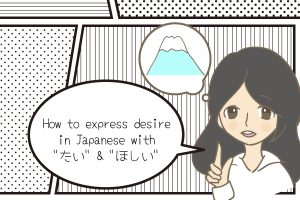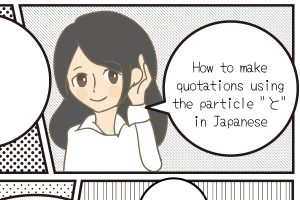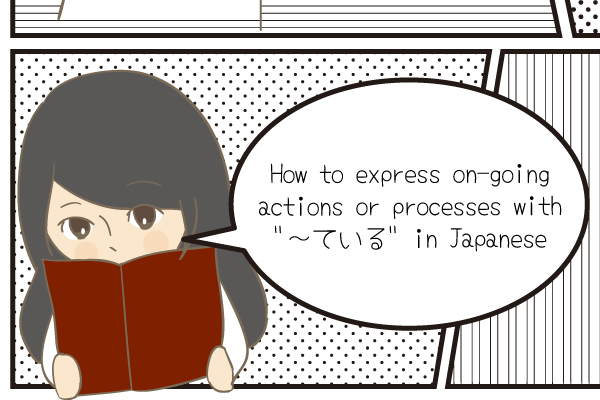In our last lesson you learned how to express your own wishes and volition using “~たい” and “~ほしい”, as well as talk about those of others. In this lesson you will learn how to express on-going actions as well as actions with lingering effects using “~ている”.
[About “~ている”]
When speaking to your Japanese friends or watching a Japanese TV show, have you ever come across these words?
“してる”, “行ってる”, “わかってる”
They look similar to the “辞書形” (dictionary form), but also slightly different. In truth, they are all abbreviated versions of the “~ている”-form. Their proper form would be: “している”, “行っている”, & “わかっている”. They are composed of any verb in its “te”-form plus “iru” and express on-going actions or lingering effects of previous actions/occurrences. Since the difference is subtle, many learners don’t know what they mean or what to do with them. In this lesson we will practice the conjugation and look at how to use “~ている” correctly!
As mentioned before, in order to conjugate verbs with “teiru” you will need the “te”-form. If you need to brush up on the “te”-form or “テ形”, you can read up on it in this previous article! How to conjugate verbs in Japanese Part Ⅲ
[What to use “~ている” for]
Actually, the “~ている” construction has more than 8 different uses in Japanese grammar! In this lesson we will concentrate on two basic ways to use “~ている” so even beginners in Japanese can understand it easily.
① Describing ongoing actions
② Describing situations with lingering effects
[adsense]
[Describing ongoing actions]
Using “~ている” for on-going actions conveys that any kind of action that has begun at a previous moment in time is still continuing. It’s similar to the “ing”-form in English. Let’s look at an example:
今ご飯を食べている。
I am eating dinner.
Here, “~ている” indicates that the speaker has started eating at some point in the past, say 5 minutes ago, and is still eating. The action of eating is ongoing, and a movement or change is currently taking place. Another example:
本を読んでいる。
I’m reading.
The speaker indicates that they started reading a while ago and are still reading. The action of reading is ongoing.
[Describing situations with lingering effects]
In this case “~ている” indicates that the actions of someone or of something that happened have an effect that is still active at the present moment. Let’s look at an example so this becomes clearer:
車が止まっている。
The car has stopped./The car is not moving.
As you can see, this describes the car having stopped. There is no action or change taking place, but the effect of a previous action/event is on-going. Another example:
窓が開いている。
The window is open.
Here, an action has taken place (someone opened the window), but it is not on-going. The result of a previous action has a lingering effect – the window staying open!
[How to distinguish between the two uses]
Whether “~ている” refers to an on-going action or a lingering effect is determinded by the verbs you are using it with and can therefore be clearly distinguished. Here are three hints for using “~ている” correctly:
① The verbs “ある” and “いる” cannot be used together with “~ている”
② Verbs that signify actions that occur naturally usually express an on-going action when combined with “~ている”. For example “食べる”, “書く”, “勉強する”, “泣く”, “笑う”, “咲く”, “降る”, etc.
Verbs that signify actions that occur suddenly usually express lingering effects when combined with “ている”. For example “死ぬ”, “(電車が)着く”, “止まる”, “消える”, “決まる”, “触る”, “始まる”, “終わる”, etc.
[Exercise]
Now let’s practice what you’ve learned so far! We are going to give you some words out of which you can construct sentences using “~ている”. Please see below for the solutions!
① 雨、降る
② あやこさん、めがね、かける
③ 毎年、する、海外旅行
④ 子供、3人、姉、結婚する
Solutions:
① 雨が降っています。
② あやこさんはめがねをかけています。
③ 毎年、海外旅行をしています。
④ 姉は結婚していて、子供が3人います。
[Some additional points]
Lastly, let’s take a look at two more aspects of “~ている”.
First of all, especially for its second use, some might be wondering what the difference between the simple past form of verbs using “~た” and “~ている” is.
The difference lies in the knowledge of the speaker. If the speaker is aware of the previous circumstances that led to the current situation, they would use the past form “~た”. If you saw a car speed and then come to a halt, you would say “車が止まった”. If you just see a stopped car somewhere on the street, you would say “車が止まっている”.
Another point is using “~ている” in its negative form, “~ていない”. You can use “~ていない” if you want to convey that you have not been able to do or finish something you have intended to do. For example, if someone asks you: “ご飯食べた?” (have you eaten?), you could reply “まだ食べていない” (I haven’t eaten yet), conveying that you are still intending to eat. If you reply “ご飯食べなかった”, that would convey that you didn’t eat and have no intention of doing so.
So please be aware that the meaning changes completely depending on which form you use!
That’s it for today’s lesson. Make sure to practice using “~ている” and revise the “テ形” or “”te”-form if you have problems conjugating the verbs correctly.
As always, don’t forget to check out the video on this class and tune in to our livestream every wednesday at 6pm (JST) for the real deal!
| 動作 | Action, motion |
| 進行 | Progress |
| 変化 | Change |
| 状態 | Current status, condition |
| 結果 | Result |
| 窓 | Window |
| 過程 | Process |
| 様子 | Situation, circumstances |
| 道路 | Road |

How to express desire in Japanese using “たい” & “ほしい”

How to make quotations using the particle “と” in Japanese



